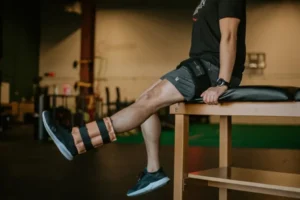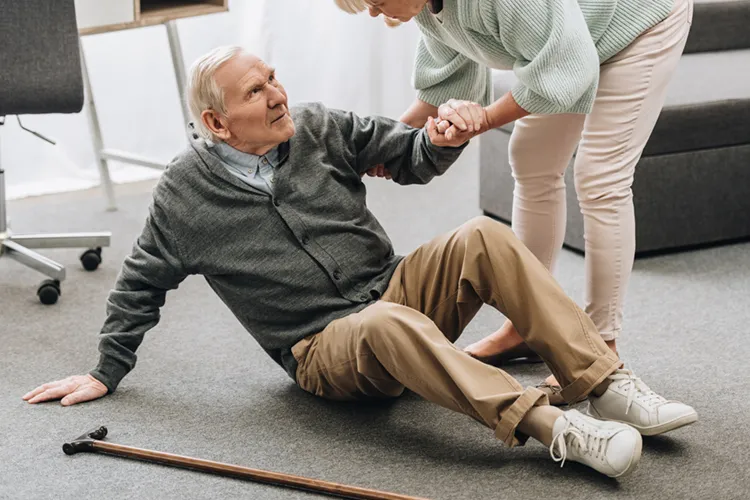
Call (239) 919-3510
Call (239) 919-3510

Experiencing a fall can be a much different experience throughout our lives. As a toddler, falling is a way of learning balance and how to navigate through the world. Moving through adolescence, falling can become a clumsy way to get made fun of on the playground or a fun way to slow down your sled going down the hill. Through our young adult to middle aged years, falling usually means an injury. Falling off the ladder, out of the vehicle, drunkenly going down over the curb, or simply not picking up our feet over obstacles. This continues through our elder years becoming even more vital as the aging process has taken its toll over the decades. The post will focus on ways to combat falling for primarily the elderly population. However, these tips and tricks can be used throughout the lifespan to keep us all upright as long as possible.
A major factor that can lead to a fall is loss of strength in the legs. This can occur to the muscles of the hip, knee, and/or ankle and impact how we move. Some falls occur while getting out of bed or off the couch while others are caused by not picking the foot up high enough to clear an obstacle, like a curb. These are examples of weakness playing a role in the fall. When we transfer from one position to another (ie. Sit to stand, stand to sit, lying down to sitting up, etc.), we are engaging multiple muscles throughout our core and legs that are used to help us control our motions. The natural aging process causes humans to lose 5-10% of their available strength every decade after the age of 30. Therefore, by the time we are 80 years old, our muscles have the capacity to generate power 25-50% less than what we could 50 years prior. While this seems like a high number, most people are able to either adjust their lifestyles or maintain a workout regimen to help combat these losses. When the proper steps are not taken to ensure proper strength is being maintained in our lower extremities, falls can occur.
Having the proper gait mechanics is another way to avoid falling. When we walk, there are a series of actions that occur to ensure we do not stub our toe or lose our balance. First, the basics. As we swing one leg forward, contact with the ground should be made first with the heel. (heel strike) We then shift our weight forward through the foot towards the toes while the opposite leg swings forward. As heel strike occurs on the opposite leg, pushing off through the toes to propel our first leg into the swinging motion should happen. In general, your heel should hit the ground first and your big toe should be the last thing touching the ground before swinging the leg forward. Due to weakness, stiffness, tightness, fear of falling, poor mechanics, etc., many people walk with a “foot flat” pattern. This type of gait avoids the push off and heel strike, reducing the stride length and reducing muscle activation through our shin muscles. The muscles along the lateral (outside) side of our shin, primarily our anterior tibialis, pull our toes up. If this muscle is not working to its full capacity, we tend to drag our toe on the ground or catch the toe on objects as we try to move over obstacles.
Proprioception is one of three components that contribute to our balance. Along with our equilibrium in our inner ear and our vision, proprioception is the knowledge of where our joints are in space. In simple terms, receptors in our joints are constantly communicating with our brains to tell the body where and how to shift weight, move, stand, walk, etc. Having proper proprioception allows us to safely navigate our surroundings. As we age, the speed with which the receptors and our brain communicate slows. This is why our reactions are not as fast as they were when we were younger. As a young adult, ascending a curb/stair or catching our balance when slipping on a wet or icy surface is much easier than when we are elderly. Proprioception is the reason for this change. Proprioception is improved through balance training. Challenging both the receptors and the speed they communicate with the brain can improve our overall balance. In physical therapy, we do this by changing our vision (eyes open vs. eyes shut), our surfaces (even vs. uneven), speed of movement, and/or changing our base of support (how wide/narrow the feet are), to name a few.
Fear of falling is a common issue that occurs as we age. While sometimes we have trouble getting out of our own brains, there are certainly safe and effective ways to train the body to increase comfort and tolerance for activities. As the confidence builds, the fear of falling decreases and individuals are able to return to all their desired activities.
Email: Info@naplespremierpt.com
Phone: (239)919-3510
Website: www.Naplespremierpt.com